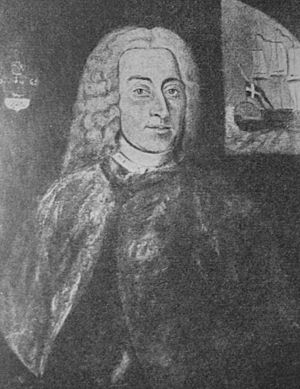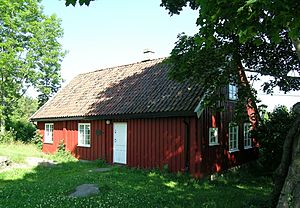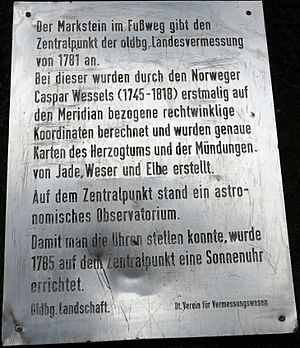Caspar Wessel facts for kids
Quick facts for kids
Caspar Wessel
|
|
|---|---|
 |
|
| Born | 8 June 1745 Vestby
|
| Died | 25 March 1818 (aged 72) |
| Nationality | |
| Alma mater | University of Copenhagen |
| Known for | Complex numbers Complex plane Vectors |
| Partner(s) | Cathrine Elisabeth Brinck f. Müller |
| Awards | Knight of the Order of the Dannebrog |
| Scientific career | |
| Fields | Mathematics |
Caspar Wessel (born June 8, 1745, in Vestby, Norway – died March 25, 1818, in Copenhagen, Denmark) was a Danish-Norwegian mathematician and mapmaker. In 1799, Wessel was the first person to explain a special way to understand complex numbers. He showed them as points on a map, called the complex plane, and also as vectors.
Contents
About Caspar Wessel
Caspar Wessel was born in a place called Jonsrud, in Vestby, Norway. His father was a pastor named Jonas Wessel. His mother was Helene Marie Schumacher.
He grew up in a large family with twelve brothers and sisters. Among his brothers were Johan Herman Wessel and Ole Christopher Wessel, who were also well-known.
Early Life and Education
In 1763, after finishing high school at Oslo Cathedral School, Caspar moved to Denmark. He wanted to study law at the University of Copenhagen. However, he faced money problems and could only study for one year.
To earn a living, he became an assistant land surveyor. He worked with his brother on mapping projects for the Royal Danish Academy of Sciences and Letters. This work involved making detailed maps of Denmark.
Because he still needed more money, he also took on extra jobs as a cartographer, which means someone who draws maps. He continued to work as a surveyor for the rest of his life. In 1778, he took a year off to finally complete his law degree. By 1798, Wessel had become the Royal Inspector of Surveying.
His Big Mathematical Idea
Caspar Wessel's work as a surveyor made him think about the math behind maps. This led him to explore the meaning of complex numbers in a new way.
His most important paper was called Om directionens analytiske betegning. He presented it in 1797 to the Royal Danish Academy of Sciences and Letters.
Why His Work Was Noticed Later
Wessel's paper was written in Danish and published in a journal that was not widely read outside of Denmark. Because of this, his amazing discovery went unnoticed for almost 100 years.
Later, other mathematicians, like Jean-Robert Argand in 1806 and Carl Friedrich Gauss in 1831, discovered the same ideas on their own.
It wasn't until a Danish student wrote about "Danish mathematics in the 18th century" that Wessel's work became known. The student's supervisors realized how important Wessel's contribution was. This led to a lot of excitement and made the mathematician Sophus Lie work to make sure Wessel got the credit he deserved.
Understanding Vectors
One of the key ideas in Wessel's paper was about vectors. Even though this wasn't his main goal, he realized that numbers could have both a length and a direction, just like arrows.
He explained how to add two straight lines (vectors) by joining them end-to-end. Then, you draw a new line from the start of the first to the end of the second. This new line is their sum. This is exactly how vectors are added in math and science today.
Today, everyone agrees that Caspar Wessel was the first to think of a complex number as a point on a map. His paper was translated into French in 1897 and into English in 1999.
From 1764 to 1805, Wessel helped map Denmark, Schleswig, Holstein, and Oldenburg. Even Napoleon Bonaparte asked for his map of Schleswig-Holstein.
Personal Life and Recognition
Caspar Wessel was known for being a quiet and humble person. His brother, Johan Herman, once described him as "He draws maps and reads the law. He's as diligent as I am lazy." Sadly, no pictures of Wessel seem to have survived.
In 1780, he married Cathrine Elisabeth Brinck f. Müller in Copenhagen.
On July 1, 1815, Wessel was honored for his great work in surveying. He was made a knight of the Order of the Dannebrog. He received this special award at the Royal Palace of Amalienborg on August 4, 1815.
See also
 In Spanish: Caspar Wessel para niños
In Spanish: Caspar Wessel para niños



